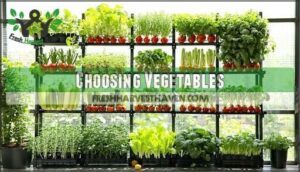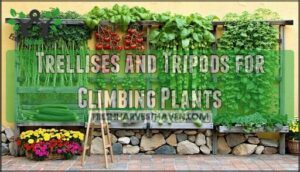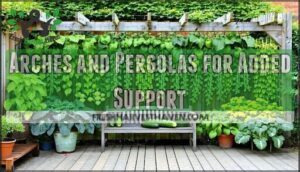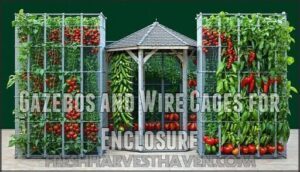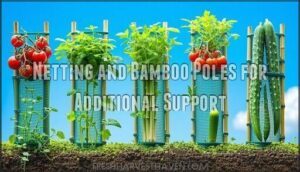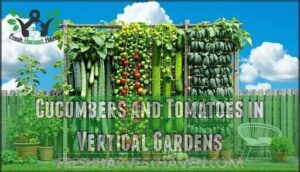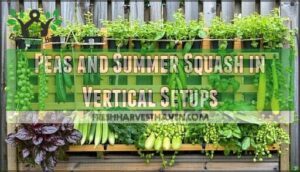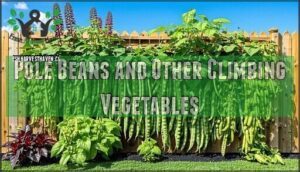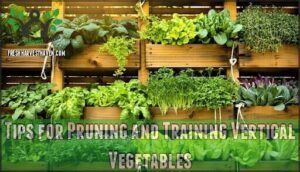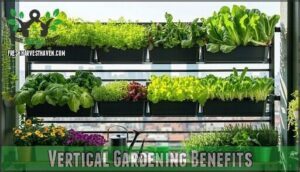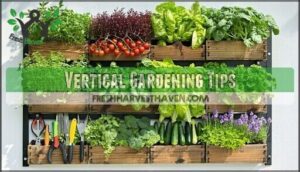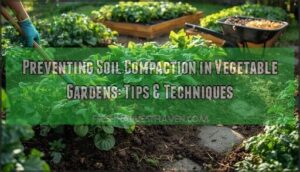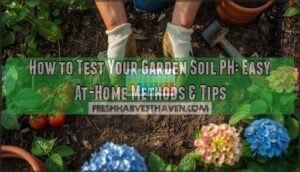This site is supported by our readers. We may earn a commission, at no cost to you, if you purchase through links.
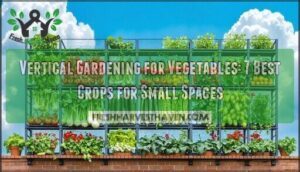
Vertical gardening for vegetables transforms small areas into productive three-dimensional gardens, perfect for balconies or compact yards.
Climbing crops like tomatoes, cucumbers, pole beans, and peas thrive in vertical systems while improving air circulation and reducing disease risk.
This method triples your harvest potential compared to traditional ground-level planting.
You’ll also enjoy easier harvesting since vegetables hang at eye level rather than requiring you to bend over constantly.
The secret lies in choosing the right vegetables and support structures for your specific space.
Table Of Contents
- Key Takeaways
- Vertical Gardening Basics
- Choosing Vegetables
- Vertical Gardening Structures
- Growing Vertical Vegetables
- Vertical Gardening Benefits
- Vertical Gardening Tips
- Frequently Asked Questions (FAQs)
- What grows best in a vertical garden?
- What are the disadvantages of vertical gardening?
- What vegetables do not grow well in raised beds?
- Are vertical gardens hard to maintain?
- What is a vertical vegetable garden?
- Can you grow vegetables vertically?
- What are the benefits of a vertical vegetable garden?
- What is the best plant for vertical vegetable gardening?
- Can you grow vegetables vertically in a hanging gutter garden?
- How do you position a vertical vegetable garden?
- Conclusion
Key Takeaways
- You’ll triple your harvest potential by training climbing vegetables like tomatoes, cucumbers, and pole beans to grow upward using trellises, cages, and support structures instead of spreading horizontally.
- You’ll create healthier plants with better air circulation that prevents fungal diseases like powdery mildew and blight while keeping fruits clean and off the ground.
- You’ll enjoy easier maintenance since vertical gardening brings vegetables to eye level, eliminating constant bending and making harvesting, pruning, and watering more accessible.
- You’ll maximize small spaces efficiently by transforming walls, balconies, and compact yards into productive three-dimensional gardens that optimize every square foot of growing area.
Vertical Gardening Basics
Vertical gardening transforms your small space into a productive growing area by training vegetables to grow upward instead of outward.
This space-saving technique improves air circulation around plants, reduces soil-borne diseases, and creates an attractive living wall that maximizes your harvest potential.
Maximizing Space Utilization
Transform your cramped growing area into a productive vertical oasis.
Space saving gardening through vertical cropping lets you grow upward instead of outward, perfect for urban farming enthusiasts.
Tiered planters and vertical planters maximize every square inch, turning walls into garden space optimization goldmines.
Small scale operations benefit tremendously from compact gardening techniques that stack growing zones efficiently.
Improving Airflow and Plant Health
Beyond the obvious space-saving benefits, vertical gardening creates an environment where air circulation thrives around your plants.
Looking at the paragraph about air circulation in vertical gardening, here’s a short engaging blockquote in the same tone:
**Fresh air flows freely, keeping your plants healthy and disease-free naturally.
When you elevate vegetables off the ground using trellises or towers, you’re naturally promoting better airflow that prevents the stagnant conditions where fungal diseases love to flourish.
This improved air circulation keeps foliage dry, reducing common problems like powdery mildew and blight.
Your plants breathe easier, literally – and disease prevention becomes much simpler when air moves freely through the canopy, allowing for better overall health and making vertical gardening a great method for disease prevention.
Enhancing Garden Aesthetics
Garden aesthetics flourish when you strategically layer vertical gardening structures to create stunning living walls.
Your wall gardens transform blank surfaces into vibrant green walls that showcase plant arrangements with artistic flair.
By combining climbing vegetables with decorative supports, you’ll achieve vertical landscaping that serves dual purposes.
This urban greening approach elevates garden decor while maximizing space efficiency in your outdoor sanctuary.
Effective use of vertical garden basics can substantially enhance the overall visual and functional impact of your garden design.
This approach is key to creating a beautiful and efficient outdoor space, with vertical gardening being a central element.
Choosing Vegetables
You’ll need to select plants that naturally climb or can be trained vertically to maximize your growing space effectively.
Consider each vegetable’s growth habits, support requirements, and space limitations before making your final choices.
Best Vegetables for Vertical Growing
Vining plants reveal your garden’s vertical potential, transforming cramped spaces into productive growing towers.
You’ll find success with climbing vines like pole beans and cucumbers, while leafy greens thrive in stacked containers. Root crops adapt surprisingly well to deep vertical planters.
- Climbing Vines: Pole beans, peas, and cucumbers naturally ascend trellises, maximizing your small space gardening potential
- Leafy Greens: Spinach, lettuce, and kale flourish in wall-mounted planters with their shallow root systems
- Fruit Plants: Tomatoes and peppers excel in vertical gardening setups when properly supported with cages
Factors to Consider
When choosing crops for vertical gardening, you’ll need to balance plant growth habits with your available space.
Consider each plant’s mature size, light requirements, and support needs. Fast-growing leafy greens suit shallow vertical planters, while fruiting crops need deeper containers and stronger supports.
Site preparation involves evaluating sunlight exposure, wind patterns, and structural weight limits for maximum garden yield, including assessing the need for stronger supports.
Vining and Rambling Plants
When you’re selecting vining crops for vertical gardening, you’ll discover nature’s climbing champions that transform ordinary trellises into productive green walls.
These rambling crops naturally twine, grasp, and scramble upward using tendrils or twisting stems.
Cucumbers, pole beans, and peas excel with proper vine training on climbing frames, while heavier vining crops like squash need sturdy plant supports to prevent structural collapse, ensuring the overall structure remains intact with proper vine training.
Bush-Type Crops and Their Limitations
Unlike vining crops that climb skyward, bush-type vegetables grow outward with compact growth patterns.
These bushy plants like determinate tomatoes and compact peppers offer excellent crop selection for tight spaces but require different pruning techniques.
Their dense foliage can limit airflow compared to vertical gardening with vining crops, which challenges traditional space savings strategies that vertical systems provide, while they offer space saving benefits through concentrated yields.
Vertical Gardening Structures
You’ll need sturdy support structures to help your climbing vegetables reach their full potential while keeping fruits clean and accessible.
The right framework transforms your garden into a productive vertical space that maximizes every square foot, with the right framework being crucial for this transformation.
Trellises and Tripods for Climbing Plants
Supporting climbing plants requires sturdy plant supports that match your vegetables’ weight and growth habits.
Trellises constructed from wood, metal, or PVC provide reliable vertical frames for heavy crops like indeterminate tomatoes and cucumbers.
Tripod structures offer excellent stability for pole beans reaching 12 feet tall, and these space savers maximize garden productivity while supporting vigorous vining plants effectively.
Gardeners can benefit from understanding trellis systems to create ideal vertical gardening structures, which is key to effective gardening and using trellis systems correctly.
Arches and Pergolas for Added Support
Arches and pergolas transform your vertical gardening setup into stunning architectural features while providing robust support for heavy-fruited vines.
These garden arches offer superior structural integrity compared to basic trellises, handling mature cucumber and squash plants with ease. The use of garden arches can enhance the overall aesthetic and functionality of the vertical garden.
- Pergola designs create overhead growing space for sprawling crops like grapes and kiwis
- Arch supports frame pathways while supporting climbing beans and peas on both sides
- Vertical frames distribute plant weight evenly, preventing sagging under heavy harvests
- Garden trellises integrate seamlessly with arch structures for maximum growing potential
Gazebos and Wire Cages for Enclosure
Wire cages and gazebos transform your vertical gardening space into protected growing environments.
These Enclosure Types create microclimates while supporting heavy fruiting plants like tomatoes and squash.
| Structure Type | Best Uses | Materials |
|---|---|---|
| Wire Cages | Tomatoes, peppers, eggplants | Galvanized steel, vinyl-coated wire |
| Garden Gazebos | Bean tepees, cucumber towers | Cedar, treated lumber, metal frames |
| Enclosed Trellises | Peas, climbing flowers | Wire mesh, bamboo, composite materials |
Gazebo Designs offer multiple Vertical Supports within one structure, while Wire Cage Materials like galvanized steel provide durability.
Garden Fencing integrated into these systems creates boundaries that help train vining crops upward rather than sprawling outward.
Netting and Bamboo Poles for Additional Support
When choosing netting materials for vertical gardening, you’ll find plastic mesh and wire options offer varying support durability for your vegetable gardening needs.
Bamboo sourcing becomes essential since proper pole placement creates sturdy support structures that handle heavy crops.
Train your plants gently through the netting while ensuring your bamboo poles anchor deep enough for long-term plant support stability, which is crucial for vertical gardening and requires careful consideration of netting materials.
Growing Vertical Vegetables
You’ll discover that growing vegetables vertically transforms your garden into a productive, space-saving system that maximizes yield while minimizing ground space.
This technique allows you to train climbing crops like tomatoes, cucumbers, and pole beans upward using support structures, creating healthier plants with improved air circulation and easier harvesting access.
Cucumbers and Tomatoes in Vertical Gardens
Indeterminate tomatoes and vining cucumbers transform vertical gardening into a productivity powerhouse.
You’ll need sturdy trellises for cucumber care, while tomato pruning keeps growth manageable.
Vertical training maximizes garden productivity in containers.
Support heavy fruit with hammocks or slings.
These crops thrive when trained upward, delivering exceptional yields through proper vertical gardening techniques.
Peas and Summer Squash in Vertical Setups
Pea varieties transform vertical garden space through their natural climbing ability, while summer squash requires creative vertical training techniques.
Cool-season peas thrive on sturdy trellises during spring and fall, making room for heat-loving vining plants through crop rotation.
Summer squash needs strong support systems since they’re not natural climbers, but proper vertical gardening methods maximize your growing potential in compact areas, utilizing sturdy trellises and vertical training.
Pole Beans and Other Climbing Vegetables
Several climbing varieties transform your vertical space into a productive tower. Pole beans reach 6-8 feet using twining stems that spiral around vertical supports. These vigorous vining plants require sturdy trellises positioned during planting for ideal garden layout and space optimization.
To achieve successful growth, understanding indoor seed starting is essential for a successful harvest.
- Purple-podded varieties add stunning color contrast while producing abundant harvests
- Heirloom climbing peas deliver sweet pods that kids love picking at eye level
- Scarlet runner beans create living walls with vibrant red flowers attracting beneficial pollinators
Tips for Pruning and Training Vertical Vegetables
When training vertical vegetables, you’ll master essential pruning techniques that transform your garden maintenance routine.
Start training when seedlings reach 6-8 inches, using soft ties every 6-12 inches on your trellis.
Regular vegetable pruning concentrates energy on fruit production while improving airflow, and strategic vertical training increases yields by 35% in vegetable planters.
Weekly plant support adjustments prevent entanglement, which is crucial for a successful and productive garden.
Vertical Gardening Benefits
When you grow vegetables vertically, you’ll maximize your garden’s potential while simplifying your daily care routine.
You’ll discover that vertical systems create healthier growing conditions that naturally boost plant performance and fruit quality, leading to overall better results with vertical systems.
Increased Space Efficiency
Vertical structures transform cramped spaces into productive gardens by maximizing your growing potential upward instead of outward.
Space saving techniques like tiered planters and garden towers let you cultivate more vegetables in compact areas, making urban farming accessible even in tiny backyards or balconies.
Efficient landuse through vertical cropping multiplies your harvest potential exponentially, and by using techniques like these, you can make the most of your space, which is a key factor in urban farming.
Easier Harvesting and Maintenance
You’ll discover that vertical gardening transforms maintenance from backbreaking work into efficient, accessible tasks.
Elevated plants eliminate constant bending and kneeling, while vertical structures bring produce to eye level for easier harvesting and garden maintenance.
- Accessible Tools: Reach vegetables at comfortable heights without straining your back or knees during daily care
- Vertical Pruning: Perform precise cuts and training on eye-level plants using standard gardening shears and ties
- Efficient Watering: Install drip irrigation systems that deliver moisture directly to root zones with reduced labor
Healthier Plants and Reduced Diseases
While easier harvesting keeps your back happy, vertical gardening also boosts plant health through better airflow and sunlight exposure.
This setup encourages Disease Resistance and Fungal Control by drying leaves faster, limiting infection.
Raised supports improve Soil Sanitation and Pest Management, reducing disease pressure.
With these gardening techniques, you’ll see healthier crops and significant disease reduction—key benefits of modern vertical farming.
Improved Fruit Appearance and Quality
When you grow vegetables vertically, gravity becomes your ally in creating picture-perfect produce.
Fruit alignment improves dramatically as tomatoes and cucumbers hang naturally straight, eliminating the curved, misshapen forms common in ground-grown crops.
Vertical pruning and stem training keep fruits clean and unblemished, while enhanced air circulation promotes vibrant color enhancement and superior fruit quality throughout your vertical farming system.
Using proper vertical gardening techniques can substantially enhance the overall health and appearance of your vertically grown vegetables.
Vertical Gardening Tips
You’ll need proper soil, watering, and support systems to maximize your vertical garden’s potential. These foundational techniques guarantee healthy plant growth and abundant harvests in your space-efficient setup.
Soil Quality and Nutrient Management
Creating healthy soil conditions in vertical gardens requires strategic planning since containers limit root space and nutrient cycling.
Your vertical setup needs well-draining soil with proper pH levels between 6.0-7.0 for ideal plant nutrition.
Essential soil management practices:
- Soil Testing – Test pH and nutrient levels every 4-6 months to maintain proper fertilizing schedules
- Compost Usage – Mix 40% compost with topsoil to boost nutrient supply and improve soil structure
- Fertilizer Options – Use controlled-release fertilizers for steady nutrition or liquid feeds for quick uptake
- Drainage Enhancement – Add 30% perlite or coconut coir to prevent waterlogged soil conditions
Understanding soil health basics is vital for maintaining a thriving vertical garden ecosystem.
Watering and Irrigation Techniques
Through proper irrigation and soil monitoring, you’ll maintain ideal water levels without overwatering your vertical vegetables.
Drip irrigation systems deliver precise moisture directly to root zones, promoting efficient water conservation. Check soil moisture regularly using your finger or moisture meters.
Rainwater harvesting provides sustainable water sources, while sprinkler systems work for larger setups.
Smart watering schedules prevent nutrient leaching and support healthy plant nutrition throughout the growing season. Effective drip irrigation systems are essential for maintaining healthy vertical gardens, utilizing proper irrigation techniques to ensure optimal growth.
Plant Support and Pruning Strategies
Support becomes the backbone of vertical success when you anchor plants properly and guide their growth strategically.
Sturdy trellis systems and well-timed pruning create the framework for productive harvests.
- Trellis Systems: Install robust garden structures before planting—cucumbers love tent-shaped designs while tomatoes thrive on pipe fan configurations
- Pruning Tools: Use clean, sharp shears to remove suckers and redirect energy into fruit production rather than excessive foliage growth
- Plant Training: Secure vines gently with soft ties, guiding them upward along supports while preventing damage to delicate stems and branches
Stake usage varies by crop weight—lightweight peas need simple twine while heavy squash demands reinforced cage designs and hammock supports.
Ongoing Maintenance and Pest Control Measures
Weekly monitoring catches 80% of pest infestations early in vertical gardens.
You’ll prevent disease risks through proper pruning techniques and sterilized tools, reducing transmission by 80%.
Soil monitoring with moisture meters optimizes plant health while preventing fungal diseases from overwatering.
Water conservation through drip irrigation keeps foliage dry, cutting disease control needs by 50%.
Strategic pest management beats reactive garden maintenance every time, ensuring a healthy and thriving garden through proper pruning.
Frequently Asked Questions (FAQs)
What grows best in a vertical garden?
Why struggle with sprawling garden beds when you can grow vertically?
Climbing plants like pole beans, cucumbers, and peas thrive on trellises, while tomatoes excel with proper support systems.
You’ll maximize space efficiency and simplify harvesting.
What are the disadvantages of vertical gardening?
You’ll face higher costs, constant watering needs, and limited root space. Heavy plants require sturdy support systems, while wind exposure and uneven light distribution can stress your crops substantially.
What vegetables do not grow well in raised beds?
Like trying to squeeze a square peg into a round hole, deep-rooted vegetables struggle in raised beds.
You’ll find tap-rooted crops like long carrots, daikon radishes, and parsnips can’t penetrate deeply enough for proper development.
Are vertical gardens hard to maintain?
You’ll find vertical gardens surprisingly manageable with proper planning.
While they require consistent watering and occasional pruning, modern irrigation systems and accessible plant placement actually make maintenance easier than traditional ground-level gardens, which can be considered manageable.
What is a vertical vegetable garden?
You’re creating a space-saving garden system that grows vegetables upward using supports like trellises, cages, or towers instead of spreading horizontally across ground space.
Can you grow vegetables vertically?
Yes, you can successfully grow vegetables vertically using trellises, cages, and support systems. Tomatoes, cucumbers, peas, beans, and leafy greens thrive when trained upward, maximizing your growing space efficiently.
What are the benefits of a vertical vegetable garden?
Vertical gardens boost yields by 30% per square foot compared to traditional plots.
You’ll maximize space, reduce pest problems, improve air circulation, and make harvesting easier while keeping fruits cleaner off the ground, which also helps to improve air circulation.
What is the best plant for vertical vegetable gardening?
Pole beans reign supreme for vertical gardens, climbing 6-8 feet with minimal space requirements. You’ll harvest continuously throughout summer while their nitrogen-fixing roots actually improve your soil naturally.
Can you grow vegetables vertically in a hanging gutter garden?
You’ll grow shallow-rooted leafy greens like lettuce, spinach, and herbs beautifully in hanging gutters. Root vegetables won’t thrive since they need deeper soil depth than gutters provide.
How do you position a vertical vegetable garden?
Choose a spot with 6-8 hours of direct sunlight and easy access for maintenance. Position your structure against a sturdy wall or fence, ensuring proper drainage and wind protection.
Conclusion
Studies show that vertical gardening for vegetables can increase yields by up to 300% per square foot compared to traditional horizontal methods.
You’ve learned that proper structure selection and plant training create thriving three-dimensional gardens in minimal space.
Your tomatoes, cucumbers, and pole beans will flourish with improved air circulation and easier maintenance access.
Remember that consistent watering, strategic pruning, and sturdy support systems guarantee vertical gardening for vegetables success in any compact growing area.

